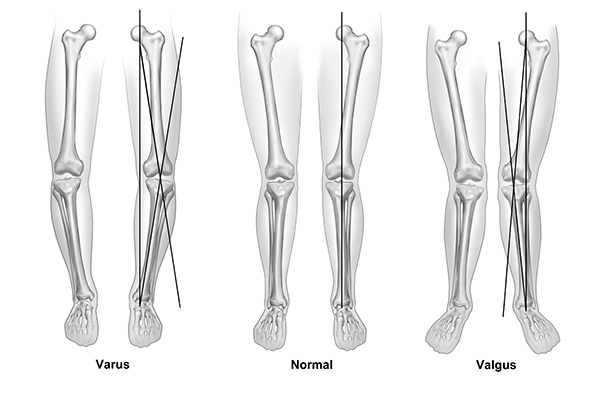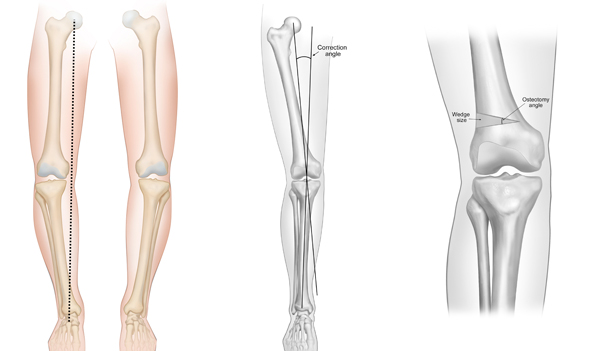Knee Malalignment
There are three bones that make up the knee joint – the femur (thigh bone), the tibia (shin bone), and the patella (kneecap). The long axis of the leg refers to an imaginary line that runs length of the leg, from the center of the hip joint down to the center of the ankle joint. This axis helps define the orientation and alignment of the leg bones. Maintaining proper alignment along the long axis of the leg is crucial for normal biomechanics and efficient movement. Deviations from the normal alignment affect the distribution of forces across the knee joint.
Knee malalignment is the deviation of the knee joint from its normal or neutral position along the long axis of the leg. There are two types of knee malalignment: genu valgum (knock knee) and genu varus (bow-legged). Genu valgum is a knee malalignment where the knees angle inward and touch each other when the legs are straightened. Genu varus is a condition where the knees curve outward, creating a gap between the lower legs when the feet are together. Both knee varus and valgus misalignments can potentially lead to issues with the biomechanics of the knee joint, increasing the risk of injury or contributing to conditions like osteoarthritis over time.

Knee malalignment can be caused by genetic factors, developmental issues, nutritional deficiencies, and certain medical conditions, such as ligament laxity, muscle imbalance, and Rickets disease.
- Knee Alignment: When standing with the feet together, there may be a visible bowing of the knees (varus alignment) or knock-knees (valgus alignment) while the ankles touch or nearly touch.
- Gait Abnormalities: Individuals with knee malalignment may exhibit altered gait mechanics during activities such as walking or running.
- Pain and Discomfort: Due to abnormal stress on the structures supporting the knee, varus alignment can potentially lead to pain or discomfort around the medial (inside) aspect of the knee whereas valgus alignment can lead to pain or discomfort on the lateral (outside) aspect of the knee.
- Instability: The altered alignment may contribute to feelings of instability, especially during weight-bearing activities.
The combination of a detailed history, comprehensive physical examination, x-rays, and possibly an MRI or CT scan is the key to a successful diagnosis of knee malalignment. Dr. Jorge Chahla and his team will complete a thorough exam to evaluate your gait mechanics, range of motion, stability, and points of tenderness to palpation. A long-limb x-ray will be obtained and will allow Dr. Chahla to measure the degree of malalignment. An MRI may be ordered to assess for possible associated meniscal or cartilage injury due to the additional strain that knee malalignment causes on the medial knee compartment (varus alignment) or lateral knee compartment (valgus alignment). Finally, a CT scan may be necessary to further study the bony anatomy and degree of malalignment of the knee.

Knee malalignment can lead to discomfort, instability, and progressive joint damage if left untreated. Whether due to congenital factors, injury, or wear and tear over time, improper knee alignment can affect mobility and increase the risk of osteoarthritis. If you are experiencing knee pain, difficulty walking, or worsening joint function, Dr. Jorge Chahla, a leading orthopedic knee surgeon, provides expert diagnosis and treatment options to restore proper alignment and improve joint health. With offices in Chicago, Naperville, and Oak Brook, Dr. Chahla offers advanced, personalized care to help patients regain stability and function. Contact his office today to schedule a consultation.
At a Glance
Dr. Jorge Chahla
- Triple fellowship-trained sports medicine surgeon
- Performs over 800 surgeries per year
- Associate professor of orthopedic surgery at Rush University
- Learn more


